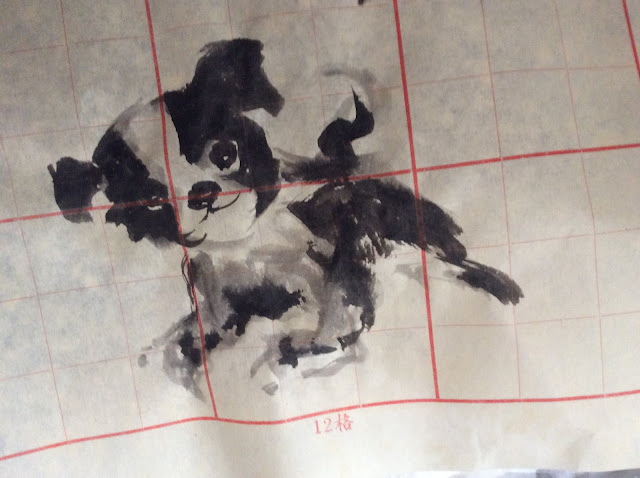I also refined and vine and bud on the bottom of the painting.
As I had mentioned, I was caught up a bid with the venerated traditions of either Gongbi or Xieyi styles of rendering until I decided to say "screw that"; but I still need some credible and efficacious
way of defining forms and details. After much trepidation I settled on the principle of contrasts. I used black or no lines at all to define light areas. I traced thin black outlines amongst the white petals so one could tell them apart, with the help of light shading of course. These black lines would be written using center tip, transitioned to side tip when I needed to add thickness to the line, as when I was trying to depict the edge of a petal.. I used a thin sliver of void to define a dark form against a dark background. Thus when I was adding to the dark values of the backdrop I took special care to allow unpainted borders to form around the leaves.
The effect was actually quite stunning. I could really grasp the high contrast effect I was aiming for.
Xuan being an absorbent piece of paper could really play havoc with a wet brush. To minimize any unwanted bleeding out of my brush strokes I drafted my hair dryer blower into service. The trick was to blow dry my brushstrokes before they had the time to bleed and migrate. For the most part I was able to preserve that pristine little white lines around the dark leaves and stems.
Armed with this new narcissistic excitement I worked on the dark leaves some more to give them more structure and detail
I had thought about stopping right here. But then I thought the two tones of black in the backdrop was too exaggerated so I decided for a smoother transition.
There was this one petal in the flower and its profile was standing straight up, thus presenting itself as a thin white line. Visually speaking it created quite a challenge to give it a body. I tried to create an interesting black line with varying thickness to describe the undulation but needed to add to its white value. How to make a void more "white" was my dilemma. The easiest way would be to paint those areas with either titanium white or white gouache but that would totally destroy that je ne sais quoi quality of a translucent Xuan. Perhaps I could illustrate my case as when we could see internal organs on a small guppy fry or a small shrimp; it's a delicate sight to behold. That same sight gave me the idea of painting the white gouache on the back side of the translucent Xuan. Now that area appeared "whiter" when viewed from the top side, and yet showed no trace of pigments on the paper. Unadulterated innocence!
viewed from the back side of the paper
Stamping my seals presented a problem since the backdrop is deep black. I cheated by stamping the normal way, then selectively painted in the seal with vermilion and titanium white for lettering. I smudged up the chops ever so slightly to give them that weathered look. It added character ( pun ).
Finally the finished piece
Yes, I quite like it; especially when viewed from a distance under illuimnation. I really enjoyed the treatment of the white edges, as if the plant was back lit. It does have that pop without being harsh. It does impart a special feeling, sentiment; to me anyways.
I am emoting.

























































